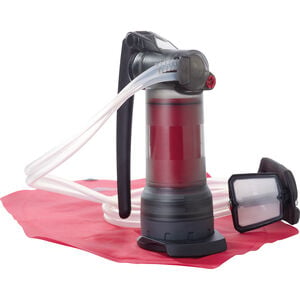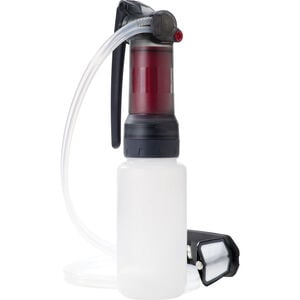Why do I need a filter or purifier?
All surface waters have the potential to be contaminated with at least one of the three types of disease-causing microorganisms:
protozoa,
bacteria, and
viruses. While it is true that you can drink directly from many water sources, it is critical to understand that each time you do, there is a chance of ingesting one of these bugs. Infection symptoms can range from an upset stomach to debilitating illness and, depending on where you are, can mean anything from a simple inconvenience to a life-threatening situation. Since microorganisms are impossible to see, taking the proper precautions with any water can help to ensure a safe trip.
How is a filter different from a purifier?
The main difference lies in the level of protection they provide. Generally speaking, a water filter is designed to remove waterborne protozoa and bacteria, but not viruses. A water purifier is designed to combat all three classes of microbes, including viruses.
Because North American backcountries are regarded as low-risk for viruses, filters typically offer a sufficient water treatment method. In places heavily trafficked by humans or where sanitation systems are poor, the risk for viruses increases. In these areas, such as in developing countries, a purifier is recommended.
Additionally, filters physically remove matter and microbes from the water. In contrast, a "purifier" can employ a variety of methods to do so, from physically removing the contaminants to disinfecting the water of them, through UV or chemical treatments.
Why the two treatment device options? The reason is, viruses are just too small for filters to catch. Far smaller than protozoa or bacteria, viruses slip through the technologies used in backpacking filters. Traditionally, UV light, chemical treatments or boiling were required to deactivate viruses by scrambling their DNA or killing them. Today, new advancements in physical purifiers provide a convenient option to physically remove viruses quickly and easily.
The flow rates of physical purifiers are generally slower than that of filters, because the internal media that removes contaminants has to be small enough to capture tiny viruses. This slows the rate at which water passes through the media, decreasing overall flow rate.
What is the scoop on protozoan parasites?
Protozoa are the largest of the waterborne bugs measuring in the one-micron range. Giardia and cryptosporidia are the most infamous of the group. The infective cysts and oocysts of protozoa are extremely robust and can survive for months in a water source. They thrive in domestic and wild animals as well as humans. Cryptosporidia oocysts are known for their resistance to chemical treatment. Most disinfectants are ineffective, and the few that are require long dwell times to do the job.
What is the scoop on bacteria?
Bacteria are an order of magnitude smaller than protozoa measuring in the 0.5 - 2 micron range. The most well-known bacteria are E. coli; others include Leptospira (which causes Leptospirosis), Campylobacter, Salmonella, and Shigella. Bacteria aren't as hearty, surviving in water only for weeks instead of months. However, unlike protozoa and viruses, which require a host to multiply, some bacteria can grow in water and so can be found in higher numbers than protozoa and viruses. Bacteria, like protozoa, are often carried by both animals and humans. Because of this, many water sources are contaminated with bacteria. Beware especially of sources near agricultural operations.
What is the scoop on viruses?
Viruses are the smallest type of pathogen, ranging between 0.02 - 0.3 microns. Waterborne viruses are very resilient and can survive for months. It is important to note that viruses are generally species-specific. In other words, those that infect animals do not infect humans and vice versa. Because of this, and the well-maintained sewage systems in developed countries, not as many water sources are contaminated with human viruses. However, in heavily traveled backcountry areas, viruses can be present where human waste is not disposed of properly. In developing countries with little or no sewage control, viruses are often widespread and purification in such countries should be standard procedure for all travelers.
What happens if I drink water that contains viruses, bacteria and protozoa?
First, it will usually take more than one organism to make you sick—around 10 for protozoa and viruses and 10 to 1,000,000 for bacteria depending on the species. The onset of symptoms can start anywhere from 10 hours to several weeks from the point of infection depending on the type and amount ingested, and constitution of the individual. Symptoms can range from nothing to diarrhea, abdominal cramps and pain, nausea, vomiting, muscle cramps, fever, fatigue, headache, chills, loss of appetite, and, in the case of hepatitis, dark urine and jaundice. Symptoms usually dissipate in a couple of days or weeks, again depending on the three elements above. Healthy adults will generally knock the illness without needing medical attention and without lasting effects. However, infants, young children, elderly, pregnant, and immune-compromised individuals are at higher risk of needing medical attention or having complications from an illness. Your location—a remote basecamp in Pakistan or a day hike close to home— will play a key role in the severity of your illness, should you become infected. For more information on diseases caused by specific pathogens, please visit www.cdc.gov.
What do MSR filters remove from the water?
A filter actually removes matter and microbes from the water while a "purifier" can employ a variety of methods to disinfect the water (such as UV or MIOX® or combination system like the MSR Sweetwater® purifier). A purifier must meet the EPA Guide Standard for Testing Microbiological Purifiers, which requires inactivation of all three classes of microbes: protozoa, bacteria and viruses. Filters in general claim to remove only protozoa and bacteria, making it adequate for most travel in developed countries. Some filters alone can qualify as a purifier, but since they are filtering to such a small pore size, they tend to clog quickly. Essentially the classification as a "purifier" means that the device must be capable of inactivating viruses, as well as protozoa and bacteria.
What does inactivate mean?
Inactivate means to damage a microorganism sufficiently to render it harmless.
How do I decide whether a filter or a purifier is best for me?
To decide whether you need a filter or a purifier, two important factors must be evaluated: water sources and susceptibility.
When evaluating water sources it is important to keep the following in mind: In general, protozoa and bacteria infect both animals and humans and are transmitted to water sources by animal and human waste. In contrast, waterborne viruses are species-specific and therefore transmitted to water sources by human waste alone. As a rule of thumb, remote areas with few people require (at least) filtration while popular areas with many human visitors require purification. If traveling in developing countries with poor sanitation, purification will be your safest choice.
Susceptibility is another good way to determine needs. If the treated water is to be consumed by infants or young children, elderly, or pregnant or immunocompromised individuals, then it is essential to use a purifier for the highest level of protection. Purification is also best for people who tend to get sick. If you rarely get sick and do not fit into any categories mentioned above, then filtration may be adequate depending on the water source.
What pore size or micron rating are the MSR filters?
Micron ratings aren't always the best way to gauge effectiveness. Test procedures for micron ratings vary so greatly that comparing them is misleading. In addition, micron ratings for filters do not tell you how the product will perform with actual bugs. There is an EPA Guide Standard for Testing Microbiological Purifiers, which describes how to test products to determine if they are removing or inactivating the proper number of pathogens in different types of water throughout the life of the device. When looking for a microfilter or purifier ask if the product has been tested according to the EPA Guide Standard and passed. For a microfilter, meeting the EPA Guide Standard means removing 99.9% of protozoa and removing 99.9999% of bacteria in all required water types. To be classified as a purifier, the device must meet the EPA Guide Standard for the removal of protozoa and bacteria as well as virus which must be inactivated to 99.99% in all required water types. All of the MSR filters and purifiers have passed the levels of inactivation required by the EPA Guide Standard with flying colors.
Will my filter or purifier protect me from bioterrorism?
As a result of the September 11 attack and the following concerns about bioterrorism, we have received a number of inquiries regarding our microfilters' ability to protect against such threats. MSR microfilters will protect you from harmful microorganisms that are 0.2 microns or larger. The anthrax bacteria, for example, measures about 8 microns and would be removed by all MSR filters. Additionally, if a water reservoir were contaminated with a biological agent, it is unlikely that enough organisms could be added or would survive the treatment process of the water plant to provide an infectious dose at the tap. Our water supply is more likely to be compromised or cut off completely as a result of a natural disaster, such as an earthquake or hurricane, or by a general state of disorder following any kind of attack or natural disaster. By including a good water treatment device (and knowing how to use it) in your emergency kit, you will be prepared for most situations.
Do MSR filters and purifiers remove chemical contaminants from the water?
MSR filters and purifiers provide microbiologically safe drinking water. Several MSR filters feature a carbon component that reduces some chemical contaminates such as herbicides, pesticides, and volatile organic compounds (VOCs). However, MSR filters or purifiers will not protect you from high chemical concentrations or heavy metal contamination. Do your best to avoid water sources such as mining tailing ponds or those near agricultural operations.
How will tannins (tea-colored water) affect my filter or purifier?
MSR filters will remove some tannins from the water you are filtering. Like other contaminants, they will clog your filter over time, requiring you to clean the cartridge. Tannins will react with disinfectants and can make treated water taste unpleasant. If possible, look for a clear water source to prolong the life of your filter and improve the taste of purified water.
What is the warranty on MSR filters and purifiers?
MSR filters and purifiers come with a limited warranty. Contact our Warranty and Repairs Department at 1-800-531-9531 if there are any problems with your filter or purifier and they will be happy to help with solutions.
If I own a TrailShot filter, can I purchase the dirty water bag and adapter to create my own Trail Base gravity system?
Not at this time. Your TrailShot filter is not compatible with the gravity components of the Trail Base Water Filter Kit. Therefore, we don’t sell those gravity components separately. While the TrailShot filter and the small filter in the Trail Base Kit look similar, they are indeed different—particularly their spouts and prefilters. Therefore, the TrailShot will not integrate with the Trail Base’s gravity components. We are considering making design adjustments that will allow for integration in the future.
What is a purge valve and hose, and why does the Guardian Gravity Purifier have one?
The Guardian Gravity Purifier features a purge hose and valve to self-clean the system, no backflushing required. Open the purge valve to flush dirt and air until the water color matches the source water and is free of bubbles. This helps increase the flow rate, because air trapped in the purifier cartridge can reduce water flow. Hold the cartridge horizontally or gently tap the cartridge as water flows to help release the air.
Please note, the purge valve releases highly concentrated dirty water from the purifier. Do not allow any drops from the purge hose to splash into your clean water.
Why is my gravity filter or purifier flow rate slow?
Gravity filters and purifiers rely on the physics of gravity to pull water down through the filter/purifier media and into your clean water receptacle. The higher the dirty reservoir bag is above the clean water output, the better the flow rate will be.
To increase the flow rate, first try hanging the reservoir bag as high as you can above the clean water output. Second, make sure to purge air out of the system following the directions included with the filter or purifier (also found in the Videos section).
If your filter or purifier has seen a significant amount of use, it may be time for a replacement filter/purifier piece.
































![Gear Junkie | Top Gear Picks 2015]](https://www.msrgear.com/on/demandware.static/-/Library-Sites-cdiSharedLibrary/default/dwfeaeefda/images/award_logos/GJ_Top_Gear_Pick_2016.jpg)





